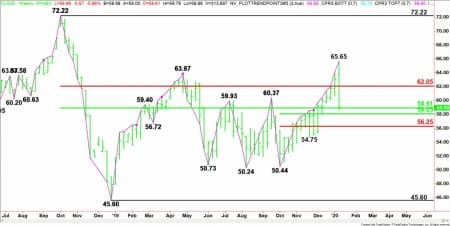U.S. West Texas Intermediate crude oil futures are in a position to finish sharply lower for the week after hitting a multi-month high just a few days ago. The selling pressure is being provided by speculators who continue to erase the risk premium in the market by dumping long positions placed as hedges against the escalation of the conflict between the United States and Iran.
The market is not bearish, per se, despite the aggressive selling pressure. It continues to be underpinned by the hope that the new trade deal between the United States and China would lead to global demand growth. Furthermore, traders are hoping the deeper production cuts buy OPEC and its allies would offset some of the increase in U.S. output.
Recap of Key Weekly Events
On Wednesday, the markets dropped nearly 5% after U.S. President Donald Trump’s comments on the Iran conflict eased investor worries about further escalation of geopolitical risks in the Middle East. Early in the session, prices had surged about 4% in response to an Iranian attack on an Iraqi airbase that houses American troops.
Weekly Inventories Report Divergence
Fundamentally, this week’s industry report was bullish, but the government report was bearish. This creates a divergence that will need to be addressed by traders in the near future.
Furthermore, if you look at the data in both reports, gasoline supply is growing. This is being blamed on a drop in demand. It could lead to a back-up in…
U.S. West Texas Intermediate crude oil futures are in a position to finish sharply lower for the week after hitting a multi-month high just a few days ago. The selling pressure is being provided by speculators who continue to erase the risk premium in the market by dumping long positions placed as hedges against the escalation of the conflict between the United States and Iran.
The market is not bearish, per se, despite the aggressive selling pressure. It continues to be underpinned by the hope that the new trade deal between the United States and China would lead to global demand growth. Furthermore, traders are hoping the deeper production cuts buy OPEC and its allies would offset some of the increase in U.S. output.
Recap of Key Weekly Events
On Wednesday, the markets dropped nearly 5% after U.S. President Donald Trump’s comments on the Iran conflict eased investor worries about further escalation of geopolitical risks in the Middle East. Early in the session, prices had surged about 4% in response to an Iranian attack on an Iraqi airbase that houses American troops.
Weekly Inventories Report Divergence
Fundamentally, this week’s industry report was bullish, but the government report was bearish. This creates a divergence that will need to be addressed by traders in the near future.
Furthermore, if you look at the data in both reports, gasoline supply is growing. This is being blamed on a drop in demand. It could lead to a back-up in crude supply until this issue is taken care of. This could keep a lid on any rally.
U.S. Energy Information Administration Weekly Inventories Report
Crude oil prices were also hit hard on Wednesday after U.S. crude oil stockpiles rose unexpectedly last week and gasoline inventories surged by their most in a week in four years, the Energy Information Administration (EIA) said on Wednesday. The report offset Tuesday’s slightly bullish numbers released by the American Petroleum Institute (API).
The EIA reported that crude inventories rose by 1.2 million barrels in the week ending January 3 to 431.10 million barrels, compared with analysts’ expectations in a Reuters poll for a 3.6 million-barrel drop.
U.S. gasoline stocks surprised as well, rising by 9.1 million barrels in the week to 251.6 million barrels, compared with expectations in a Reuters poll for a 2.7 million-barrel rise. That was the largest one-week gain in gasoline inventories since January 2016. Gasoline supplied over the last four weeks was 0.4% lower than the same period a year ago due to weak demand.
American Petroleum Weekly Inventories Report
Late Tuesday, the API reported a large crude oil inventory draw of 5.95 million barrels for the week ending January 3, compared to analyst expectations of a smaller 4.10 million-barrel draw in inventory.
The API also reported a huge build of 6.70 million barrels of gasoline for the week ending January 3, threatening to erase any price gains in crude oil due to the larger than expected draw. Traders were looking for gasoline inventories to increase by 2.654-million barrels for the week.
Distillate inventories saw a build of 6.40 million barrels for the week, while Cushing inventories fell by 1.0 million barrels.
Conclusion
Traders should continue to look for heightened volatility over the next week because it doesn’t usually go away overnight. Additionally, speculators are likely to remain active over the near-term because of the possibility that proxy militias in Iraq will continue to try to inflict damage on U.S. and Iraqi interests. However, a large price rise is not expected to stick over the long-run unless there is an actual disruption in the oil supply.
Trading volume could also drop off because the 8% price swing over a 24 hour period has probably wiped out traders on both sides of the market.
In the absence of an escalation of the conflict between the U.S. and Iran, gains are likely to be capped because inventories may rise in the first quarter, but also underpinned by hopes of increased demand.
Technical Analysis
Weekly February West Texas Intermediate Crude Oil Technical Analysis

Weekly Trend indicator
The main trend is up according to the weekly swing chart. However, momentum is shifting to the downside with the formation of a closing price reversal top. A trade through $65.65 will signal a resumption of the uptrend, while a move through $50.44 will change the main trend to down.
A change in trend is highly unlikely, but there is room for a 2 to 3 week correction into a 50% to 61.8% retracement zone. This is a normal reaction.
The minor trend is also up. It will change to down on a trade through $54.75.
The main range is $72.22 to $45.60. Its retracement zone at $58.91 to $62.05 is controlling the longer-term direction of the market.
The short-term range is $50.44 to $65.65. Its retracement zone at $58.05 to $56.25 is a value area.
Weekly Forecast
Based on this week’s price action, the direction of the February WTI crude oil market the week-ending January 17 is likely to be determined by trader reaction to the 50% level at $58.91.
Bullish Scenario
A sustained move over $58.91 will indicate the presence of buyers. If this can create enough upside momentum then look for a possible test of the Fibonacci level at $62.05. The market will strengthen if buyers can overcome the Fib level.
Bearish Scenario
A sustained move under $58.91 will signal the presence of sellers. The first target is the short-term 50% level at $58.05. Buyers could come in on the first test of this level. If it fails as support then look for the selling to possibly extend into the 61.8% level at $56.25.
Technical Conclusion
The trend is up. The selling pressure is being fueled by traders lifting hedges. Traders will be looking for value and the best zone is $58.05 to $56.25. The market straddled this zone for five weeks before the spike to the upside. So look for buyers to return on a test of this zone.
The chart pattern suggests that $58.05 to $56.25 is a balance area given the current supply/demand fundamentals.


















